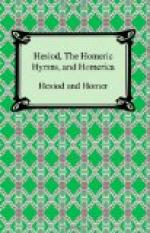This tendency to introduce romantic episodes led to an important development. Several poems are ascribed to Hesiod, such as the “Epithalamium of Peleus and Thetis”, the “Descent of Theseus into Hades”, or the “Circuit of the Earth” (which must have been connected with the story of Phineus and the Harpies, and so with the Argonaut-legend), which yet seem to have belonged to the “Catalogues”. It is highly probable that these poems were interpolations into the “Catalogues” expanded by later poets from more summary notices in the genuine Hesiodic work and subsequently detached from their contexts and treated as independent. This is definitely known to be true of the “Shield of Heracles”, the first 53 lines of which belong to the fourth book of the “Catalogues”, and almost certainly applies to other episodes, such as the “Suitors of Helen” (9), the “Daughters of Leucippus”, and the “Marriage of Ceyx”, which last Plutarch mentions as `interpolated in the works of Hesiod.’
To the “Catalogues”, as we have said, was appended another work, the “Eoiae”. The title seems to have arisen in the following way (10): the “Catalogues” probably ended (ep. “Theogony” 963 ff.) with some such passage as this: `But now, ye Muses, sing of the tribes of women with whom the Sons of Heaven were joined in love, women pre-eminent above their fellows in beauty, such as was Niobe (?).’ Each succeeding heroine was then introduced by the formula `Or such as was...’ (cp. frags. 88, 92, etc.). A large fragment of the “Eoiae” is extant at the beginning of the “Shield of Heracles”, which may be mentioned here. The “supplement” (ll. 57-480) is nominally Heracles and Cycnus, but the greater part is taken up with an inferior description of the shield of Heracles, in imitation of the Homeric shield of Achilles ("Iliad” xviii. 478 ff.). Nothing shows more clearly the collapse of the principles of the Hesiodic school than this ultimate servile dependence upon Homeric models.
At the close of the “Shield” Heracles goes on to Trachis to the house of Ceyx, and this warning suggests that the “Marriage of Ceyx” may have come immediately after the `Or such as was’ of Alcmena in the “Eoiae”: possibly Halcyone, the wife of Ceyx, was one of the heroines sung in the poem, and the original section was `developed’ into the “Marriage”, although what form the poem took is unknown.
Next to the “Eoiae” and the poems which seemed to have been developed from it, it is natural to place the “Great Eoiae”. This, again, as we know from fragments, was a list of heroines who bare children to the gods: from the title we must suppose it to have been much longer that the simple “Eoiae”, but its extent is unknown. Lehmann, remarking that the heroines are all Boeotian and Thessalian (while the heroines of the “Catalogues” belong to all parts of the Greek world), believes the author to have been either a Boeotian or Thessalian.




